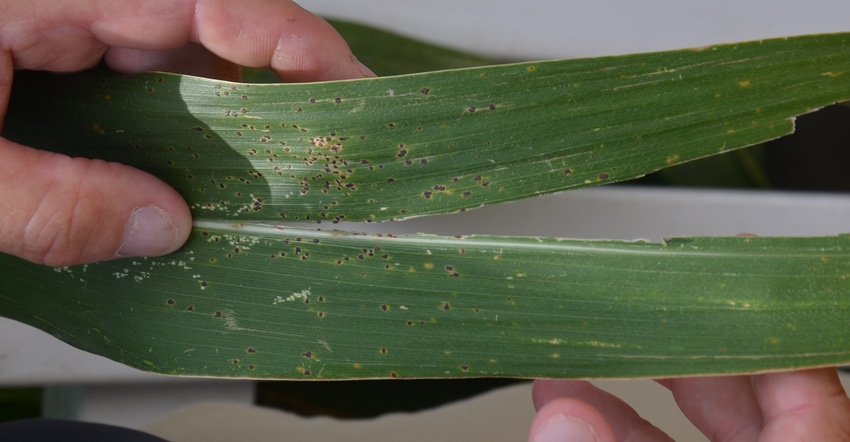
Tar spot was first detected in the U.S. in 2015, but it now has the undivided attention of a USDA Agricultural Research Service research team based in West Lafayette, Ind. Growers fight this corn disease with fungicides. However, Steve Goodwin, an ARS plant pathologist, says plants that have resistance to tar spot are preferable.
While participating universities conduct research on timing of fungicides and other control measures, Goodwin and his team are concentrating on four fronts:
1. Screening current material. The team is screening existing commercial varieties and germplasm lines for resistance or susceptibility to tar spot. The goal is to help growers adjust management practices as soon as possible depending upon which hybrids they grow.
2. Developing molecular markers. These tools will identify Qrtsc8, the gene that confers tar spot resistance. Investigators are also exploring why some plants that lack this gene are still resistant, since an unknown gene or genes could be involved.
3. Determining biocontrol potential. A microbiome of organisms was found on tar spot-resistant plants, but not on susceptible plants. Researchers want to know how these organisms, plant growth stage and the environment are interconnected in the progression of tar spot.
4. Understanding how tar spot works. Scientists also want to learn how the tar spot fungus uses several proteins to short-circuit defenses of susceptible plants. Identification of these proteins could lead to better detection of different strains of the fungus and its severity in the field.
Albaugh launches seed treatment
You may not know the name, but you may have used some of Albaugh’s products. Albaugh LLC is the largest global, privately held producer of herbicides, fungicides, insecticides, plant-growth regulators and seed treatments. Recently, Albaugh launched Anchor 3L ST, a new water-based seed treatment formulation that provides improved stability vs. standard metalaxyl. The first of three new fungicides Albaugh intends to launch over the next 24 months, it delivers seed and seedling protection against pythium and phytophthora. Learn more at albaughllc.com.
Inmarsat launches Elera IoT platform
If IoT sounds like Greek to you, you’re not alone. However, it’s worth getting used to the term, which stands for the “Internet of Things,” because those in the internet world say it will only become more important in the future. Inmarsat recently launched Elera IoT, which is built on the backbone of Inmarsat’s Elera platform for satellite connectivity.
Still not sure what it means? Spokespersons for Inmarsat say it’s a global, fully mobile, easy-to-use connectivity tool that will help businesses fuel IoT innovations. The bottom line is that it will provide a new set of tools to those producing and distributing goods across the global supply chain, including within agriculture. Get a full picture of what this platform is about at inmarsat.com.
Verifying carbon credits
Taranis, based in Westfield, Ind., and Albo Climate, from Tel Aviv, Israel, are teaming up to make verification of carbon sequestration in farmland more efficient. Achieving carbon sequestration by changing management practices is the backbone behind programs offering payment for carbon credits to farmers.
The companies will provide satellite-based remote sensing, which significantly reduces the cost of verifying what’s known in the industry as soil organic carbon, or SOC. Company leaders believe this more cost-effective solution, which takes soil sampling out of the equation, will allow more farmers to enter the carbon market. Visit taranis.ag.
About the Author(s)
You May Also Like




